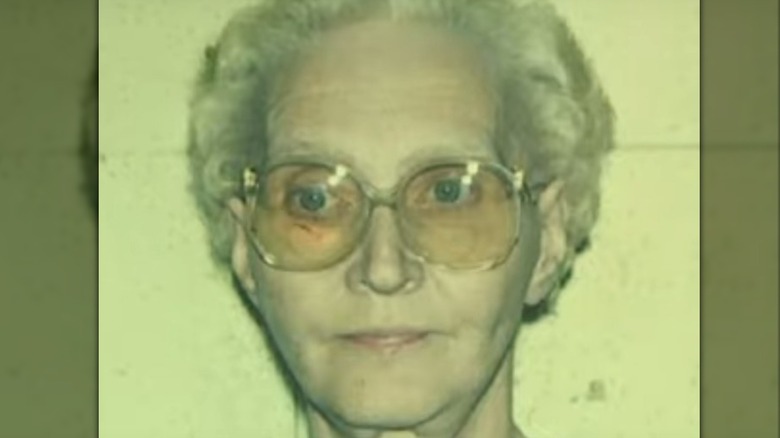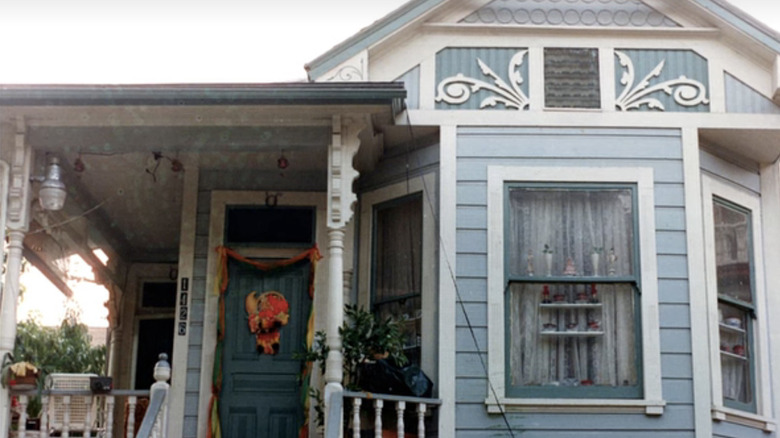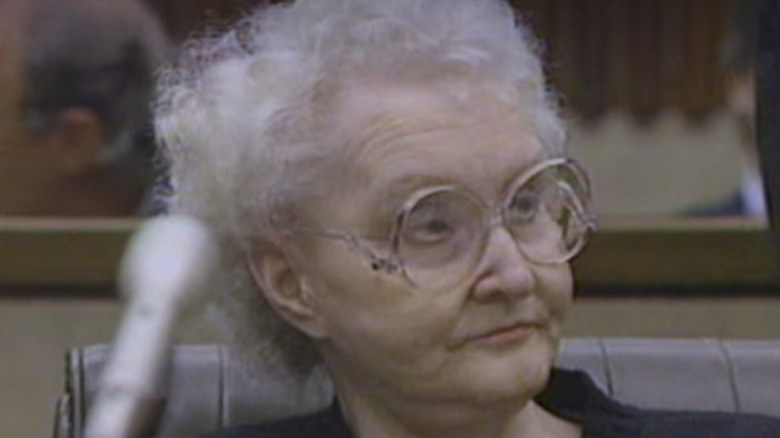What Happened To Dorothea Puente's Victim Leona Carpenter?
The first episode of the hit Netflix five-part docu-series "Worst Roommate Ever" covers the chilling murders committed by Dorothea Puente (above), known as the "Death House Landlady," according to Oxygen. Appearing like an innocent grandmother, Puente was charged with killing nine people in the 1980s and '90s at her boarding house, which she operated in Sacramento, California, per Sactown Magazine. One of Puente's victims was Leona Carpenter, an elderly woman who experienced substance use issues at the time. The manner in which Carpenter died reveals how this notorious serial killer would operate.
Once put on trial, Puente was convicted of three of nine murders for which she was charged, and she was sentenced to life behind bars. She would remain in prison until she died in 2011 (via Bustle). She claimed her innocence until the end.
Of the nine people Puente was accused of killing, all were either houseless, experiencing mental health challenges, or managing substance use issues, just like Carpenter. Her boarding house was meant to be a haven for such individuals. But instead of leaving Puente's home rehabilitated, at least nine of them wound up dead. This made Puente's crimes just that much more heinous.
The first body found
Leona Carpenter's murder may not have ever come to light if it a social worker hadn't followed up on one of her clients, Alvaro "Bert" Montoya. He was a man with mental health issues and developmental delays who had checked into Puente's boarding house and subsequently disappeared. At first Puente claimed Montoya had gone to Mexico, per Sactown Magazine. As further investigation revealed, he had gone not far at all, but instead, he was dead and buried in Puente's backyard. He had been poisoned. His was not the first body discovered behind Puente's home. The first belonged to Leona Carpenter, per New York Post.
Additional victims of Puente's include Everson Gillmouth, Dorothy Miller, Benjamin Fink, James Gallop, Betty Palmer, Ruth Monroe, and Vera Faye Martin. Each one had been poisoned, and some of them strangled, before Puente buried them. Many of Puente's victims were on social security, and the checks continued to arrive at her address, which she cashed — all part of her plan. The condition of Leona Carpenter's body when it was discovered reveals what a macabre place Puente's home really was.
Puente claimed she was innocent
As authorities excavated Dorothea Puente's backyard, what they first uncovered looked like beef jerky, as well as bits of cloth, egg shells, and bits of leather, as the New York Post reports. Soon a human femur emerged. It wasn't beef jerky at all, but instead, the flesh and bones of Leona Carpenter. At that moment, Sacramento police knew they'd uncovered a crime scene. Nevertheless, Puente said she was innocent, even after further bodies were found. Via the New York Post, one policeman said, "She was emotionless and she would look straight into my eyes and answer every question. She never flinched. She never said anything. She denied everything."
The first Puente victim discovered, Leona Carpenter, 78, had recently been released from the hospital prior to her check-in at Puente's boarding house in 1987. According to Oxygen, Carpenter was still quite ill at the time, and spent most of her time on Puente's couch. It was later determined that Carpenter died of a drug overdose, but other tenants of Puente's who witnessed Carpenter's condition said she was in no state at the time to administer those drugs to herself. Puente admitted cashing the checks of each person who died in her home, but the deaths, she said, were not her fault. Of the nine murders Puente was charged with, she would be convicted in the second-degree murder for Leona Carpenter's death.


